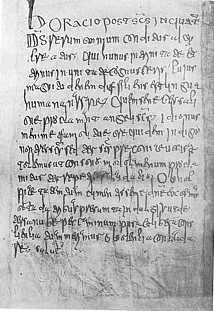 |
| Paleography
Exercises |
|
Gallican Missal, 8th century |
|
 |
This page is from a Gallican missal of the 8th century and is written in a particularly horrible, messy and illegible Merovingian minuscule script. The main reason for showing it here is not so that you can learn to read it, as to show why the Carolingian handwriting reforms were necessary if people were going to be able to read each other's writing. This particular page is written on a small piece of parchment which had been inserted into the manuscript as an addendum. The script of the rest of the manuscript is uncial. This missal was the mass book for the Gallican rite, in use in Gallic France until around the 8th century, and related to that used in Spain and Britain. The Gallican mass had no Ordinary, that is, every part of it was specific to certain feasts and religious occasions. This section is for the post Sanctus, a particular segment of the mass, to be used during Lent. |
This leaf gives us something to think about the nature of written literacy in the church at this date. The handwriting is difficult to read, not only because the script is unfamiliar to us, but because of some odd anomalies. There are some eccentricites of spelling and some very strange letter spacings, suggesting that the scribe may not have been too sure about what he was writing. The script employs many ligatures, which change the nature of how it is read. Letter combinations must be recognised as well as the individual letters in order to decode words. The script resembles Luxeuil minuscule, the very mannered and heavily ligatured book hand of the monastery of Luxeuil in France, and others influenced by its scribal culture, but it is a very scruffy example of the type. Various writers have asserted that at this date, scribes first learned a very generic style of writing based on New Roman cursive for their basic copying. The intricacies of particular house styles, including the use of ligatures, were taught within the monasteries themselves and indicate a more sophisticated level of writing literacy. |
| If that is the case, we might assume that our scribe here was still in training, his full written literacy in this complex script still under development. Of course, there is an interesting point here about the survival of manuscripts from this era. Many more have been lost than have survived, and survival is much more likely with a valued manuscript, formally produced, that is preserved for reference, than with an ordinary working copy. From that perspective, that fact that this is an added sheet in a codex produced in the more formal script of uncial may indicate that this inserted sheet is more representative of ordinary writing skills of the time and context. |
|
|
overview | text
| alphabet | abbreviations
| exercises | transcript
| translation
| |
|
Click
on each of the above to walk your way through the text. The transcript
will appear in a separate window so that you can use it for reference
at any time. These exercises are designed to guide you through the text,
not test you, so you can cheat as much as you like. |
 Script sample for this example Script sample for this example |
 Index
of Exercises Index
of Exercises |
 Index
of Scripts Index
of Scripts |
|
 |
 |